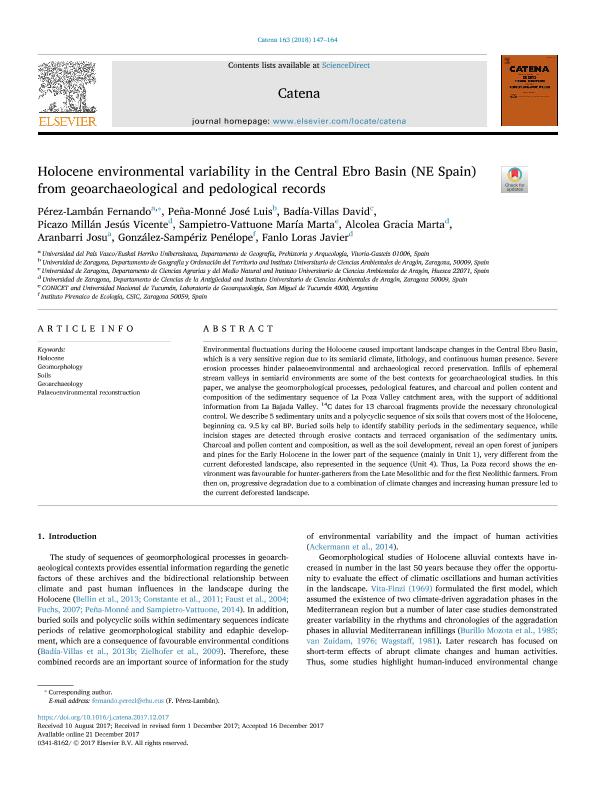Mostrar el registro sencillo del ítem
dc.contributor.author
Pérez Lambán, Fernando

dc.contributor.author
Peña Monné, José Luis

dc.contributor.author
Badía Villas, David
dc.contributor.author
Picazo Millán, Jesús Vicente

dc.contributor.author
Sampietro Vattuone, Maria Marta

dc.contributor.author
Alcolea García, Marta
dc.contributor.author
Arambarri, Josu
dc.contributor.author
González Sampériz, Penélope
dc.contributor.author
Fanlo Loras, Javier
dc.date.available
2018-12-10T13:34:08Z
dc.date.issued
2018-04
dc.identifier.citation
Pérez Lambán, Fernando; Peña Monné, José Luis; Badía Villas, David; Picazo Millán, Jesús Vicente; Sampietro Vattuone, Maria Marta; et al.; Holocene environmental variability in the Central Ebro Basin (NE Spain) from geoarchaeological and pedological records; Elsevier Science; Catena; 163; 4-2018; 147-164
dc.identifier.issn
0341-8162
dc.identifier.uri
http://hdl.handle.net/11336/66144
dc.description.abstract
Environmental fluctuations during the Holocene caused important landscape changes in the Central Ebro Basin, which is a very sensitive region due to its semiarid climate, lithology, and continuous human presence. Severe erosion processes hinder palaeoenvironmental and archaeological record preservation. Infills of ephemeral stream valleys in semiarid environments are some of the best contexts for geoarchaeological studies. In this paper, we analyse the geomorphological processes, pedological features, and charcoal and pollen content and composition of the sedimentary sequence of La Poza Valley catchment area, with the support of additional information from La Bajada Valley. 14Cdates for 13 charcoal fragments provide the necessary chronological control. We describe 5 sedimentary units and a polycyclic sequence of six soils that covers most of the Holocene, beginning ca. 9.5 ky cal BP. Buried soils help to identify stability periods in the sedimentary sequence, while incision stages are detected through erosive contacts and terraced organisation of the sedimentary units. Charcoal and pollen content and composition, as well as the soil development, reveal an open forest of junipers and pines for the Early Holocene in the lower part of the sequence (mainly in Unit 1), very different from the current deforested landscape, also represented in the sequence (Unit 4). Thus, La Poza record shows the environment was favourable for hunter-gatherersfrom the Late Mesolithic and for the first Neolithic farmers. From then on, progressive degradation due to a combination of climate changes and increasing human pressure led to the current deforested landscape.
dc.format
application/pdf
dc.language.iso
eng
dc.publisher
Elsevier Science

dc.rights
info:eu-repo/semantics/openAccess
dc.rights.uri
https://creativecommons.org/licenses/by-nc-sa/2.5/ar/
dc.subject
GEOARCHAEOLOGY
dc.subject
GEOMORPHOLOGY
dc.subject
HOLOCENE
dc.subject
PALAEOENVIRONMENTAL RECONSTRUCTION
dc.subject
SOILS
dc.subject.classification
Meteorología y Ciencias Atmosféricas

dc.subject.classification
Ciencias de la Tierra y relacionadas con el Medio Ambiente

dc.subject.classification
CIENCIAS NATURALES Y EXACTAS

dc.subject.classification
Historia

dc.subject.classification
Historia y Arqueología

dc.subject.classification
HUMANIDADES

dc.title
Holocene environmental variability in the Central Ebro Basin (NE Spain) from geoarchaeological and pedological records
dc.type
info:eu-repo/semantics/article
dc.type
info:ar-repo/semantics/artículo
dc.type
info:eu-repo/semantics/publishedVersion
dc.date.updated
2018-12-05T14:45:37Z
dc.journal.volume
163
dc.journal.pagination
147-164
dc.journal.pais
Países Bajos

dc.journal.ciudad
Amsterdam
dc.description.fil
Fil: Pérez Lambán, Fernando. Universidad del País Vasco; España
dc.description.fil
Fil: Peña Monné, José Luis. Universidad de Zaragoza; España
dc.description.fil
Fil: Badía Villas, David. Universidad de Zaragoza; España
dc.description.fil
Fil: Picazo Millán, Jesús Vicente. Universidad de Zaragoza; España
dc.description.fil
Fil: Sampietro Vattuone, Maria Marta. Universidad Nacional de Tucumán. Facultad de Ciencias Naturales e Instituto Miguel Lillo. Laboratorio de Geoarqueología; Argentina. Consejo Nacional de Investigaciones Científicas y Técnicas. Centro Científico Tecnológico - Tucumán. Unidad Ejecutora Lillo; Argentina
dc.description.fil
Fil: Alcolea García, Marta. Universidad de Zaragoza; España
dc.description.fil
Fil: Arambarri, Josu. Universidad del País Vasco; España
dc.description.fil
Fil: González Sampériz, Penélope. Instituto Pirenaico de Ecología; España
dc.description.fil
Fil: Fanlo Loras, Javier. Universidad de Zaragoza; España
dc.journal.title
Catena

dc.relation.alternativeid
info:eu-repo/semantics/altIdentifier/url/https://reader.elsevier.com/reader/sd/pii/S0341816217304198?token=CD41202BBF1DB9D0FA4AEA1F7AF93CC6890AD6878C8BB56172352648DD2D10419F1D718C745B38488AE6774BEDA397C6
dc.relation.alternativeid
info:eu-repo/semantics/altIdentifier/doi/https://doi.org/10.1016/j.catena.2017.12.017
Archivos asociados
